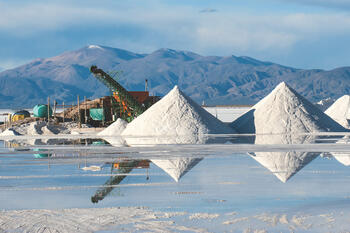
With numerous State Governor’s having issued executive orders to phase out the purchasing of gasoline driven cars within the next decade or so, and the automobile manufacturers efforts to phase into only manufacturing EV’s here’s some food for thought about the lack of transparency about “Clean Energy Exploitations”.
The typical oil well, where 100 percent organic material is pumped out of the ground, takes up around 500 to 1000 square feet. Then it flows in pipelines safely transporting the oil to refineries to be manufactured into usable oil derivatives that are the basis of more than 6,000 products for society, and into transportation fuels needed by the world’s heavy-weight and long-range infrastructures of aviation, merchant ships, cruise ships, and militaries.
The lead image (above) is just one lithium supply mine where entire mountains are eliminated. Each mine usually consists of thirty-five to forty humongous 797 Caterpillar haul trucks along with hundreds of other large equipment. Each 797 uses around half a million gallons of diesel a year. So, with an inventory of just thirty-five the haul trucks alone are using 17.5 million gallons of fuel a year for just one lithium site.
There is virtually non-existing transparency of the environmental degradation and the human rights abuses occurring in developing countries with yellow, brown, and black skinned people. Both human rights abuses and environmental degradation are directly connected to the mining for the exotic minerals and metals that are required to manufacture wind turbines, solar panels, and EV batteries.
Today, a typical EV battery weighs one thousand pounds. It contains twenty-five pounds of lithium, sixty pounds of nickel, 44 pounds of manganese, 30 pounds cobalt, 200 pounds of copper, and 400 pounds of aluminium, steel, and plastic. Inside are over 6,000 individual lithium-ion cells.
It should concern you that all those toxic components come from mining. For instance, to manufacture each EV auto battery, you must process 25,000 pounds of brine for the lithium, 30,000 pounds of ore for the cobalt, 5,000 pounds of ore for the nickel, and 25,000 pounds of ore for copper. All told, you dig up 500,000 pounds of the earth’s crust for just one battery.
The current fossil fuel infrastructure is less invasive than mining for the exotic minerals and metals required to create the batteries needed to store “green energy”. In developing countries, these mining operations exploit child labor, and are responsible for the most egregious human rights’ violations of vulnerable minority populations. These operations are also directly destroying the planet through environmental degradation. The 2022 Pulitzer Prize nominated book “Clean Energy Exploitations – Helping Citizens Understand the Environmental and Humanity Abuses That Support Clean Energy, does an excellent job of discussing the lack of transparency to the world of the green movement’s impact upon humanity.
Read the rest at CFACT.org.
Ron Stein is an engineer who, drawing upon 25 years of project management and business development experience, launched PTS Advance in 1995. He is an author, engineer, and energy expert who writes frequently on issues of energy and economics.
Photo: Lithium mine in Argentina, by Earthworks via Flickr under under CC 2.0 License.












